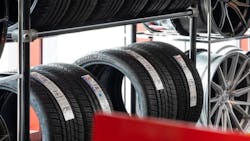Retail sellout bounced back in September, with dealers reporting sellout trends that were up slightly — in the low single digits — in September. The 1.5% increase year-over-year is an improvement compared to the 2.7% decline from August. Trends were flat to up slightly during the second quarter.
In September the regional winners were the Midwest and Southeast, which both saw positive volumes. Other regions reported flat or negative volume trends, with the Southwest showing the weakest numbers, a decline of 3.8% year-over-year.
This clarifies our picture that summer trends were muted, and shows that fall appears to have started off on the right foot, with the turn of the season putting weather and tire replacement higher on the consumer’s metaphorical to-do list. We know that October has a softer comparison, as October 2023 sellout was down 1.9%. That gives us hope that October volumes will be at least flat, or even slightly positive.
Given the volatility of the environment right now, with inflation and other macroeconomic factors, we’re curious about the health of and demand for automobile travel. Miles driven in September were up low single digits following a decline during the second quarter. Our Miles Driven Momentum Index recorded a 0.3% year-over-year increase in September, and that follows a 1.1% increase in August. These numbers continue the trend with miles driven staying ahead of pre-pandemic trends. We continue to expect to see flat-to-slightly-elevated trends for the months ahead.
Signs of fall
Dealer commentary suggests consumer demand for passenger and light truck tires in the replacement market was positive on a net basis in September, compared to the prior year. We note a net 34% of our independent tire dealer contacts saw positive demand trends in September, a sequential improvement from a net negative 14% demand trend in August.
Consumer deferment and trade down have been consistent themes over the past several months, but dealers believe we may have seen that begin to soften as consumers started to think about winter weather. That being said, we still see consumers trading down into tier-two and tier-three tires. Yet, there’s been a turn in the rate of replacement. On the negative side, dealers continue to see less demand for premium, tier-one tire brands.
Strength in tier-three
Looking at the mix of best and worst performers, our recent talks with tire dealers indicate tier-two and tier-three brands remain the most sought out by consumers during the month of September. That marks two straight months of these tires tying for the top of our rankings, and it’s the fourth straight month that tier-three tire brands being the most in-demand segment in the industry. Tier-two tires are regularly atop our survey results, but as tier-three products continue to hold at least a share of the top of the demand charts, we believe consumers are continuing to make concessions and opting for lower performance, better value tires. That trend held for tire dealers in September.
We do see volatility in these tier rankings, but overall, we still expect tier-two tire brands to be the most in demand long term, as they offer consumers a balance of cost and performance.
Rising input costs
Another thing holding steady at this point in 2024 is the overall increase in the price of the raw materials needed to build a basic replacement tire. The average price of inputs grew almost 10% during the second quarter, and is off to a fast start in the third quarter as well, with an 11.9% year-over-year increase. If the hikes of this season were to hold for the remainder of 2024, input costs would rise 10% this quarter when compared to year-ago figures.
Among the issues is that there are pressures on the supply of natural rubber from Southeast Asia, while synthetic rubber costs are also on the rise — and up double digits so far in 2024.
About the Author

John Healy
John Healy is a managing director and research analyst with Northcoast Research Holdings LLC, based in Cleveland, Ohio. Healy covers a variety of subsectors of the automotive industry and writes MTD's monthly Your Marketplace column. If you would like to be included in the monthly dealer discussions, contact him at [email protected].
